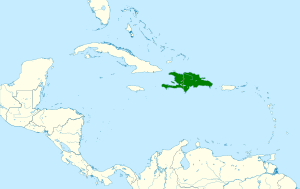Hispaniolan spindalis facts for kids
Quick facts for kids Hispaniolan spindalis |
|
|---|---|
| Conservation status | |
| Scientific classification | |
| Genus: |
Spindalis
|
| Species: |
dominicensis
|
 |
|
The Hispaniolan spindalis (Spindalis dominicensis) is a beautiful bird found only on the Caribbean island of Hispaniola. This island is shared by two countries: Haiti and the Dominican Republic. It is one of four types of spindalis birds in the family Spindalidae.
Contents
About the Hispaniolan Spindalis
For a long time, all spindalis birds were thought to be one species with different types. They were called "stripe-headed tanagers" and belonged to the tanager family. But in 1997, scientists looked closely at how these birds looked and sounded. They decided that three of these types were actually their own unique species. The Hispaniolan spindalis was one of them! The original "stripe-headed tanager" was then renamed the western spindalis.
Later, around 2017, scientists learned even more. They found that spindalis birds are not closely related to tanagers at all. So, a brand new bird family, called Spindalidae, was created just for the four spindalis species. The Hispaniolan spindalis is a "monotypic" species, which means it does not have any different types or subspecies within it.
What Does the Hispaniolan Spindalis Look Like?
This bird is about 16 cm (6.3 in) long. It weighs between 25 to 33 g (0.88 to 1.2 oz), which is about as much as a few quarters.
- Males: Adult male spindalis birds have a black head with a wide white stripe above their eyes, like eyebrows. They also have a white "moustache" stripe. Their chin is white, and they have a bright yellow patch on their throat with black on the sides. The back of their neck is a rich yellow. Their back is greenish or yellowish-olive, and their rump (the area above the tail) is a brownish-yellow color. Their tail is black with thin white edges. Their wing feathers are black with white edges, and other wing feathers are chestnut, olive, and black. Their chest is a deep reddish-brown, which gets lighter and yellower on the sides. Their belly is white, and the feathers under their tail are black.
- Females: Adult females are mostly grayish-olive. Their head is grayer, and their rump is yellowish-olive. Their tail is a dusky brown. Their underside is whitish with some dusky streaks.
- Young Birds: Young spindalis birds look a lot like adult females, but their colors are not as bright.
Where Do Hispaniolan Spindalis Birds Live?
You can find the Hispaniolan spindalis all over the main island of Hispaniola. They also live on Gonâve Island, which is off the coast of Haiti.
These birds like to live in many different kinds of humid forests. They especially like places with thick bushes and other low plants. You might also see them in fruit orchards and plantations. They can be found at almost any height above sea level, but they are most common in the mountains.
Behavior of the Hispaniolan Spindalis
Movement and Travel
The Hispaniolan spindalis lives in the same area all year long. They do not migrate far away. However, they might move to different local spots depending on where they can find the most fruit to eat.
What Do Hispaniolan Spindalis Birds Eat?
These birds mainly eat fruit. They peck open the fruit to get to the good parts. They also eat flower buds, seeds, soft leaves, and insects. They look for food everywhere, from low bushes near the ground to the very tops of tall fruit trees. Usually, they forage in pairs or small groups. But if there is a tree full of ripe fruit, many spindalis birds might gather there to eat.
Reproduction and Life Cycle
The Hispaniolan spindalis usually lays its eggs from May to June. Some pairs might even have a second group of babies after that.
They build a small, cup-shaped nest using dry grass. They place these nests in a tree or bush, usually about 4.5 m (10 ft) (about 15 feet) above the ground. A female spindalis typically lays three eggs at a time. Scientists are still learning more about how these birds raise their young.
How Do Hispaniolan Spindalis Birds Communicate?
Male spindalis birds sing a special song early in the morning. It sounds like a thin, high-pitched whistle, or a long, soft "tsee see see see." They sing this song from a high branch or hidden in thick leaves. Female spindalis birds sing a softer version of the male's song.
These birds also make calls. Some of their calls sound like a high "thseep" or a longer "seeee."
Status of the Hispaniolan Spindalis
The IUCN (International Union for Conservation of Nature) has looked at the Hispaniolan spindalis. They have decided that this bird is of "Least Concern." This means that it is not currently in danger of disappearing.
The Hispaniolan spindalis lives in a large area. Even though we do not know exactly how many of these birds there are, their numbers seem to be steady. There are no big threats to them right now. People consider them to be a common bird. Because they can live in many different places, including areas where forests have grown back, they are protected from immediate dangers, even though they only live on one island.
See also
 In Spanish: Cigua de La Española para niños
In Spanish: Cigua de La Española para niños


